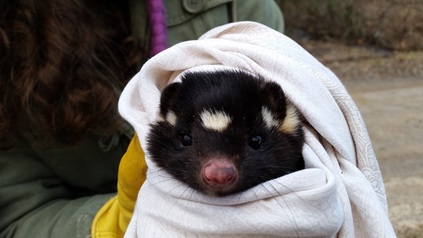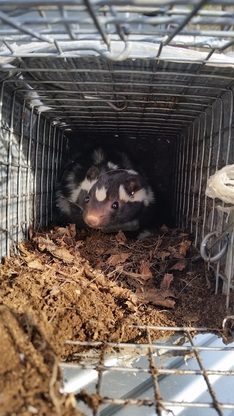Spotted Skunk Survey Project
This project has ended. Information is provided here for historical purposes.
 Captured spotted skunk. Photo by Emily Thorne.
Captured spotted skunk. Photo by Emily Thorne.
Project Overview and Purpose
Eastern spotted skunk (Spilogale putorius) populations are believed to have declined throughout much of their range in the eastern United States since the 1940s. Hypothesized declines have been attributed to habitat loss or change, increased competition with sympatric carnivore species, or diseases. Lack of information regarding the spatial distribution and habitat associations of the eastern spotted skunk in Virginia dictates the need for increased ecological study regarding this species of concern. To better understand the current distribution of spotted skunks in Virginia, we aim to determine the species’ range boundaries and habitat associations throughout Virginia using baited remote-sensing cameras. Eastern spotted skunk populations are not currently managed in the Commonwealth though the species has been rare or largely absent over the last few decades from areas where it was once abundant. Outcomes of this project will directly assist in the development of long-term, large scale monitoring as well as effective management and conservation assessments.
Eastern spotted skunk (Spilogale putorius) populations are believed to have declined throughout much of their range in the eastern United States since the 1940s. Hypothesized declines have been attributed to habitat loss or change, increased competition with sympatric carnivore species, or diseases. Lack of information regarding the spatial distribution and habitat associations of the eastern spotted skunk in Virginia dictates the need for increased ecological study regarding this species of concern. To better understand the current distribution of spotted skunks in Virginia, we aim to determine the species’ range boundaries and habitat associations throughout Virginia using baited remote-sensing cameras. Eastern spotted skunk populations are not currently managed in the Commonwealth though the species has been rare or largely absent over the last few decades from areas where it was once abundant. Outcomes of this project will directly assist in the development of long-term, large scale monitoring as well as effective management and conservation assessments.
 Spotted skunk in trap. Photo provided by Emily Thorne.
Spotted skunk in trap. Photo provided by Emily Thorne.
How To Get Involved
Interested VMN volunteers and chapters should contact Emily Thorne, the project leader, using the contact information provided on this page. An overview of what is expected of volunteers, including equipment and resources needed, is provided in the project proposal form below. A detailed project protocol will be supplied to all volunteers who sign up for the project. This project will began December 2016 and will continue at least through April 2019. Camera stations will be established in early December and checked at least once per week throughout the project.
How To Report Your Hours
The Spotted Skunk Survey project is not a statewide project in the VMN Volunteer Management System. Virginia Master Naturalist volunteers who want to participate should make sure that it is an approved project within their chapter. A project proposal form is provided below to aid in that process. Chapters may adapt this form by adding a local contact person or other details pertinent to their areas.
Spotted Skunk Survey Contacts
Emily Thorne, graduate student, Department of Fish and Wildlife Conservation, Virginia Tech
909-263-0610, [email protected]
This project is a collaboration between Virginia Tech researchers and the Virginia Department of Game and Inland Fisheries.
Volunteer Testimonials
"Working on the ESS project has taught me a lot. I have learned about the ESS, as well as many other wildlife species and their habits. The project involved baiting a trap with roadkill, and checking what comes to "feast" each week. What fun walking through the woods carrying dead meat and then tying it to a tree, in winter weather, a few feet from my field camera. Then coming home and looking through hundreds of photos of wildlife species in search of the ESS. Seriously, this has been my favorite Master Naturalist project! Can't wait to do it again!!"
-Janet Hormes
"Though it has been close to eight months since I had to close down the camera, I must say I thoroughly enjoyed the experience. Sorry to say no "spotted skunks" were sighted in our (my) particular area, but we had sightings of other very interesting "critters" that were attracted to the bait. That alone made the project worth it. However, I do hope that some day soon, someone working on this particular project will claim a new county record of the spotted skunks in Powhatan."
-Sr. Jean Ryan
"I enjoyed participating in the ESS Survey. Checking my trail camera each week was like opening a gift...
I couldn't wait to see what had been going on at the site. While no spotted skunks were discovered in my area, many other species and interesting behaviors were documented. I look forward to the opportunity to participate in this study again."
-Kim Cook
"Baiting a field camera with road kill deer, sardines or chicken gizzards wasn’t exactly on my bucket list! But walking in the winter woods to collect ecological data to help a species of conservation concern seemed like a worthy mission for sure! As a new 2016 VMN graduate of the Alleghany Highlands Chapter, the state wide field survey effort to help determine where Eastern Spotted Skunks are or are not present was an intriguing and exciting volunteer opportunity. Virginia Tech Project coordinator, Emily Thorne, did a “spot on” job prepping participants for the survey work, making it fun and letting you know that you are appreciated. Some of the benefits I enjoyed were increased knowledge of working with game cameras that I purchased, observing a wide variety of animal tracks in all kinds of weather conditions through the winter and having a mission to be in the woods as often as I could to check the camera station. I had many visitors to my camera, but no Spotties, but this was still valuable data. I look forward to participating in this citizen science field survey again this year again. I encourage other VA Master Naturalists to be part of “Team Spottie” for the coming survey."
-Tenney Mudge, VMN Alleghany Highlands Chapter
"I have never had more fun working with a group of nature lovers as I did this last winter. The inaugural year of the Virginia Spotted Skunk Survey was an incredible success. I had the honor of working with and getting to know several Master Naturalist volunteers across the state. We detected spotted skunks in Botetourt, Montgmomery, Grayson, Giles, and Nelson counties. We even found some spotties in Pendleton County, WV! Even though this last winter was warm and not very great "skunk weather" we still managed to trap and radio-collar 9 spotties which led us to catching 7 kits over the summer! I am so grateful to the Virginia Master Naturalist program and all of our volunteers. Without all of your help this project would not be possible. We are looking forward to another winter of camera surveys (fingers crossed for better skunk weather this year). New volunteers are absolutely welcome to join us in the search for these spotted stinkers!"
-Emily Thorne, Project Leader and Graduate Student, Virginia Tech
Interested VMN volunteers and chapters should contact Emily Thorne, the project leader, using the contact information provided on this page. An overview of what is expected of volunteers, including equipment and resources needed, is provided in the project proposal form below. A detailed project protocol will be supplied to all volunteers who sign up for the project. This project will began December 2016 and will continue at least through April 2019. Camera stations will be established in early December and checked at least once per week throughout the project.
How To Report Your Hours
The Spotted Skunk Survey project is not a statewide project in the VMN Volunteer Management System. Virginia Master Naturalist volunteers who want to participate should make sure that it is an approved project within their chapter. A project proposal form is provided below to aid in that process. Chapters may adapt this form by adding a local contact person or other details pertinent to their areas.
Spotted Skunk Survey Contacts
Emily Thorne, graduate student, Department of Fish and Wildlife Conservation, Virginia Tech
909-263-0610, [email protected]
This project is a collaboration between Virginia Tech researchers and the Virginia Department of Game and Inland Fisheries.
Volunteer Testimonials
"Working on the ESS project has taught me a lot. I have learned about the ESS, as well as many other wildlife species and their habits. The project involved baiting a trap with roadkill, and checking what comes to "feast" each week. What fun walking through the woods carrying dead meat and then tying it to a tree, in winter weather, a few feet from my field camera. Then coming home and looking through hundreds of photos of wildlife species in search of the ESS. Seriously, this has been my favorite Master Naturalist project! Can't wait to do it again!!"
-Janet Hormes
"Though it has been close to eight months since I had to close down the camera, I must say I thoroughly enjoyed the experience. Sorry to say no "spotted skunks" were sighted in our (my) particular area, but we had sightings of other very interesting "critters" that were attracted to the bait. That alone made the project worth it. However, I do hope that some day soon, someone working on this particular project will claim a new county record of the spotted skunks in Powhatan."
-Sr. Jean Ryan
"I enjoyed participating in the ESS Survey. Checking my trail camera each week was like opening a gift...
I couldn't wait to see what had been going on at the site. While no spotted skunks were discovered in my area, many other species and interesting behaviors were documented. I look forward to the opportunity to participate in this study again."
-Kim Cook
"Baiting a field camera with road kill deer, sardines or chicken gizzards wasn’t exactly on my bucket list! But walking in the winter woods to collect ecological data to help a species of conservation concern seemed like a worthy mission for sure! As a new 2016 VMN graduate of the Alleghany Highlands Chapter, the state wide field survey effort to help determine where Eastern Spotted Skunks are or are not present was an intriguing and exciting volunteer opportunity. Virginia Tech Project coordinator, Emily Thorne, did a “spot on” job prepping participants for the survey work, making it fun and letting you know that you are appreciated. Some of the benefits I enjoyed were increased knowledge of working with game cameras that I purchased, observing a wide variety of animal tracks in all kinds of weather conditions through the winter and having a mission to be in the woods as often as I could to check the camera station. I had many visitors to my camera, but no Spotties, but this was still valuable data. I look forward to participating in this citizen science field survey again this year again. I encourage other VA Master Naturalists to be part of “Team Spottie” for the coming survey."
-Tenney Mudge, VMN Alleghany Highlands Chapter
"I have never had more fun working with a group of nature lovers as I did this last winter. The inaugural year of the Virginia Spotted Skunk Survey was an incredible success. I had the honor of working with and getting to know several Master Naturalist volunteers across the state. We detected spotted skunks in Botetourt, Montgmomery, Grayson, Giles, and Nelson counties. We even found some spotties in Pendleton County, WV! Even though this last winter was warm and not very great "skunk weather" we still managed to trap and radio-collar 9 spotties which led us to catching 7 kits over the summer! I am so grateful to the Virginia Master Naturalist program and all of our volunteers. Without all of your help this project would not be possible. We are looking forward to another winter of camera surveys (fingers crossed for better skunk weather this year). New volunteers are absolutely welcome to join us in the search for these spotted stinkers!"
-Emily Thorne, Project Leader and Graduate Student, Virginia Tech
Project Resources
Spotted skunk research blog: http://easternspottedskunk.blogspot.com/
Project Webinar for the Spotted Skunk Survey:
Watch the video
Spotted Skunk Project on CitSci.org (data entry site): http://www.citsci.org/cwis438/Browse/Project/Project_Info.php?ProjectID=846
Spotted skunk research blog: http://easternspottedskunk.blogspot.com/
Project Webinar for the Spotted Skunk Survey:
Watch the video
Spotted Skunk Project on CitSci.org (data entry site): http://www.citsci.org/cwis438/Browse/Project/Project_Info.php?ProjectID=846
| Spotted Skunk Project Proposal Form 2018-2019 (PDF) | |
| File Size: | 196 kb |
| File Type: | |
| Spotted Skunk Project Proposal Form 2018-2019 (MS Word) | |
| File Size: | 108 kb |
| File Type: | doc |
| Spotted Skunk Survey Protocol 2018-2019 (PDF) | |
| File Size: | 68 kb |
| File Type: | |
| Spotted Skunk Survey Data Sheet - MS Excel | |
| File Size: | 12 kb |
| File Type: | xlsx |
| Spotted Skunk Survey Do Not Disturb Sign | |
| File Size: | 94 kb |
| File Type: | |
Selected Images from the Volunteers' Camera Traps
